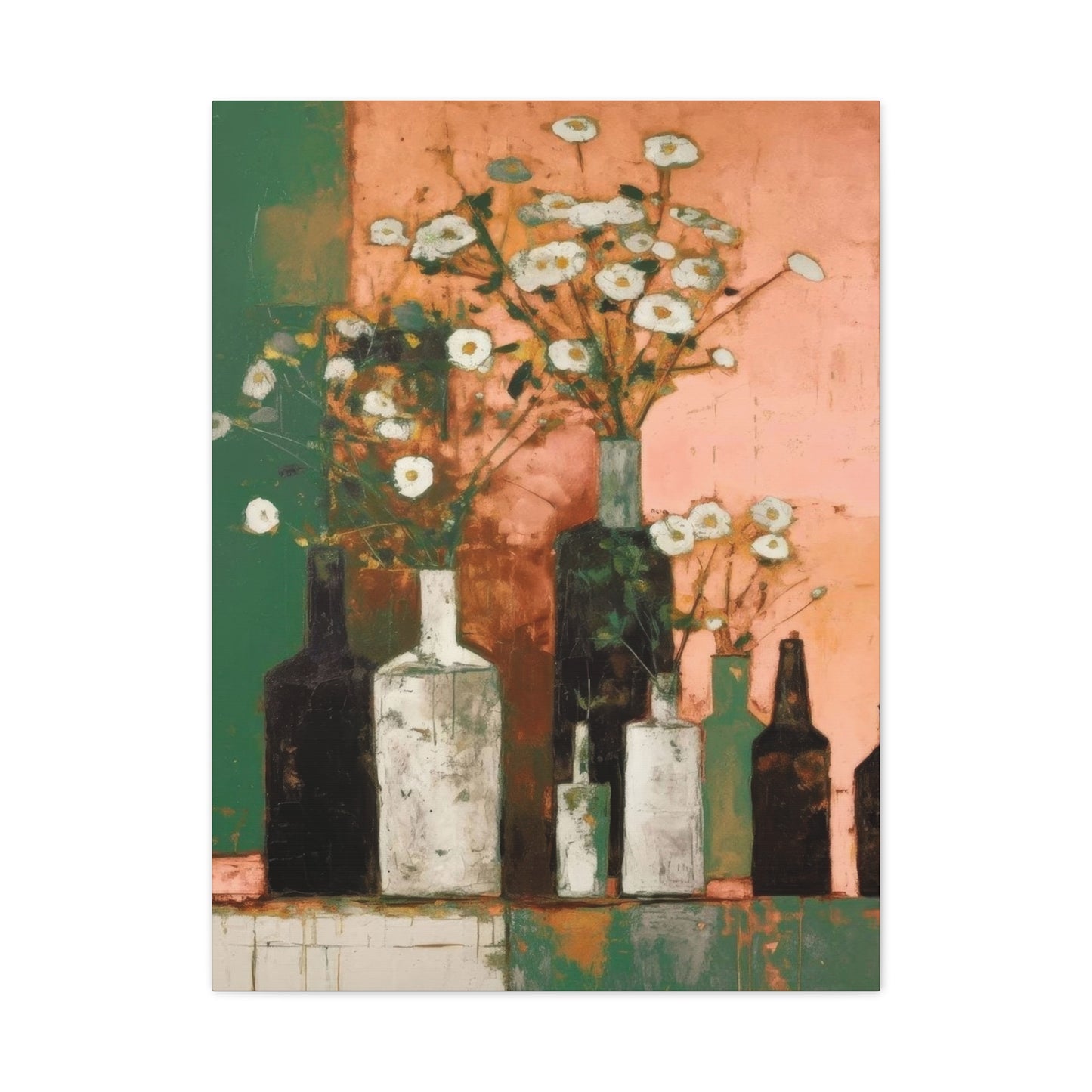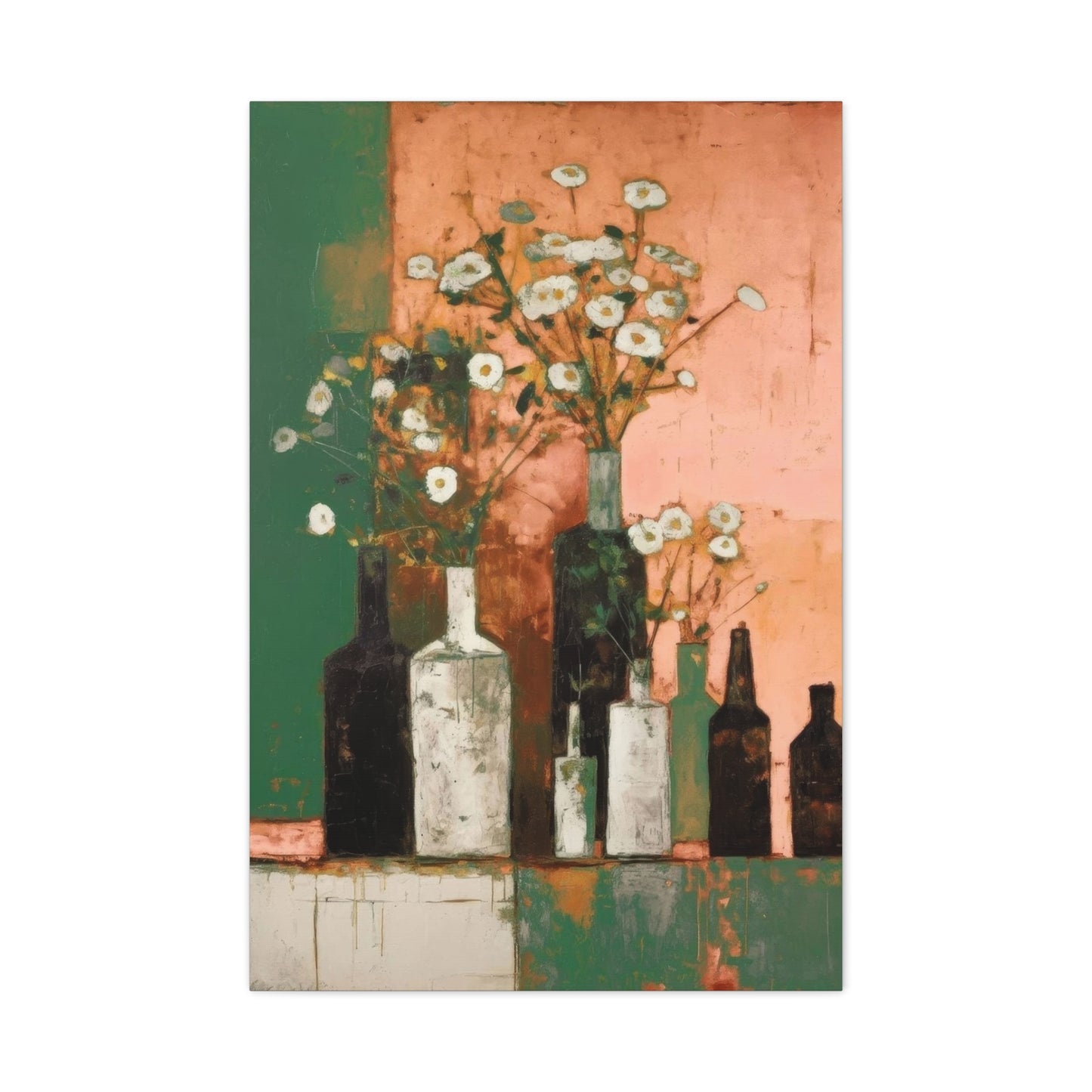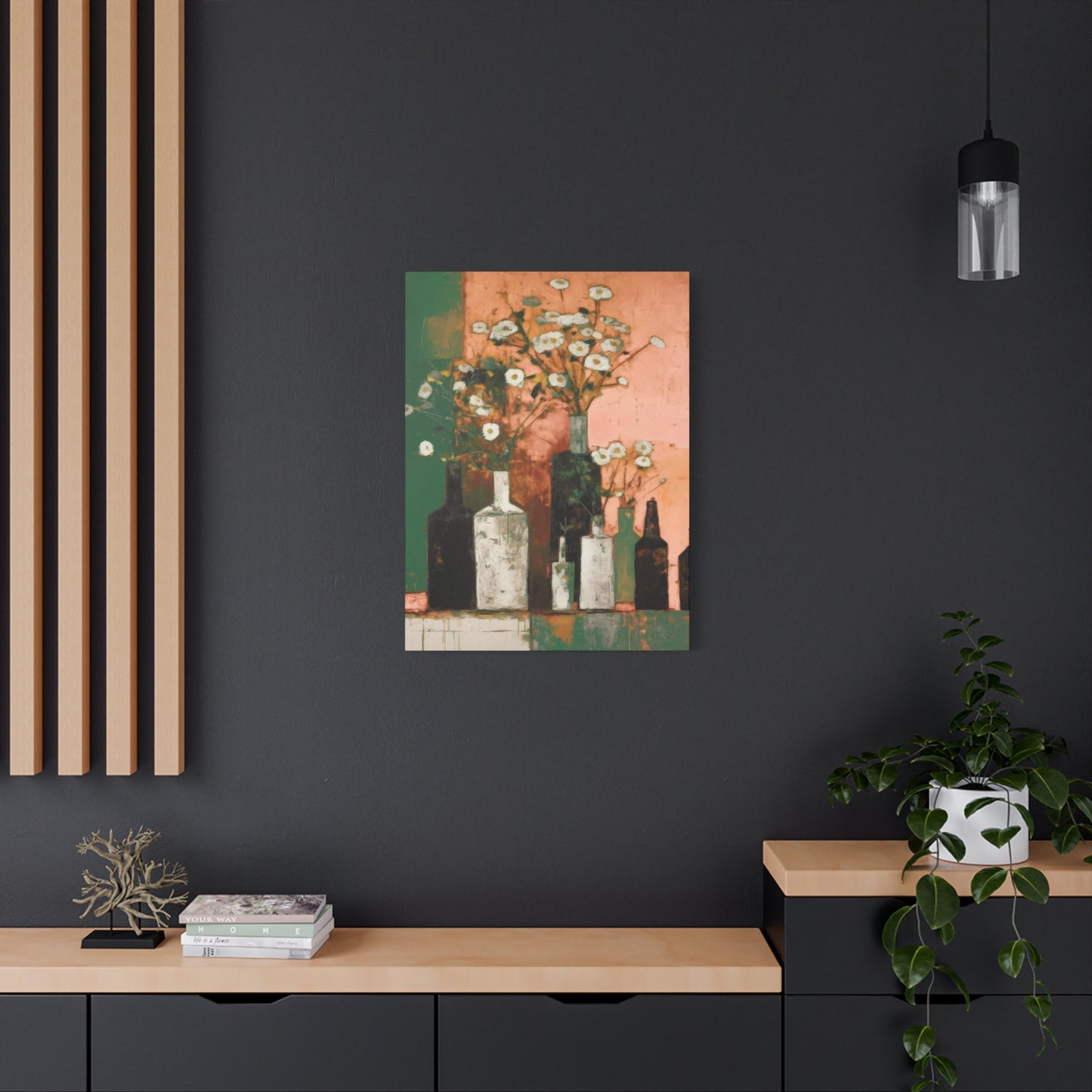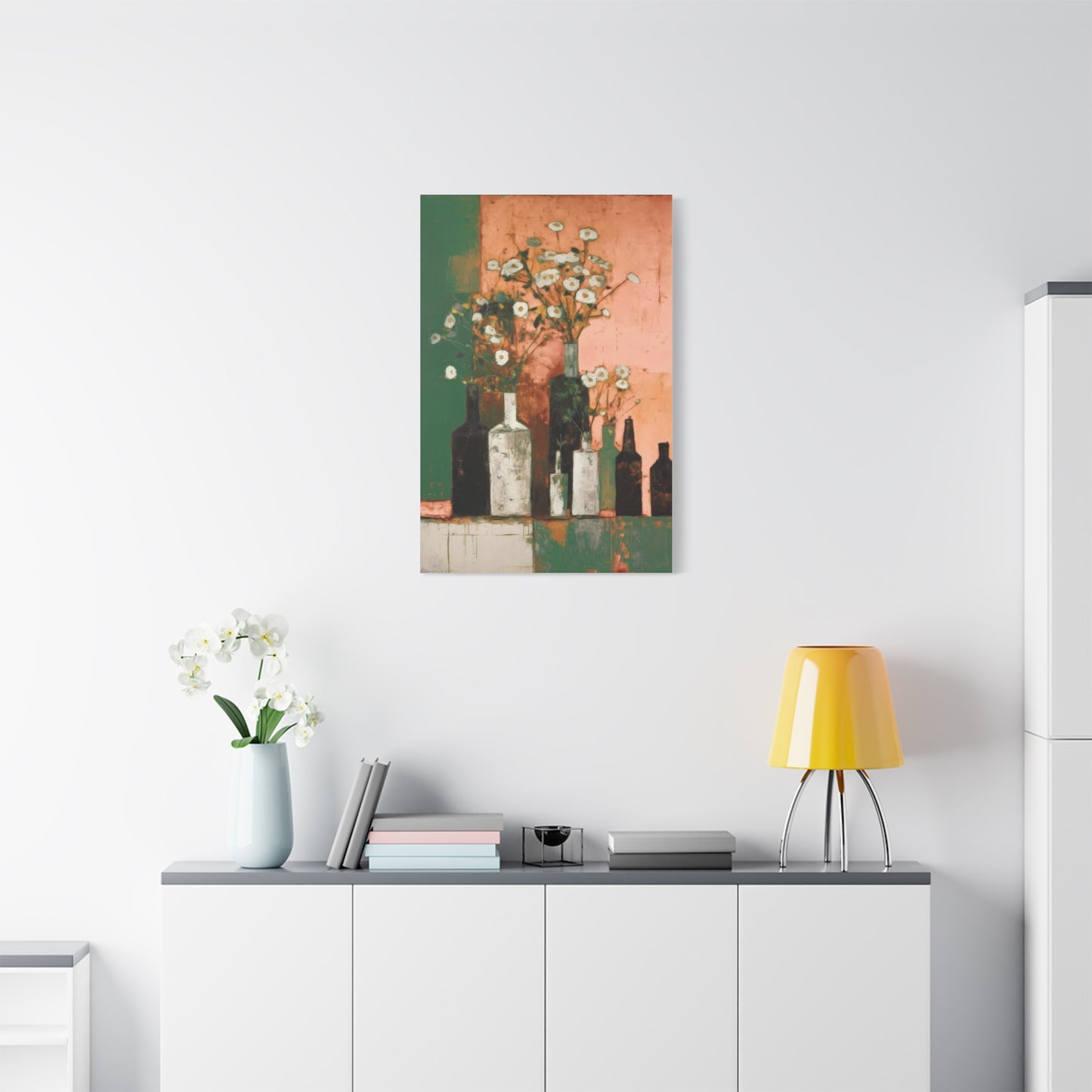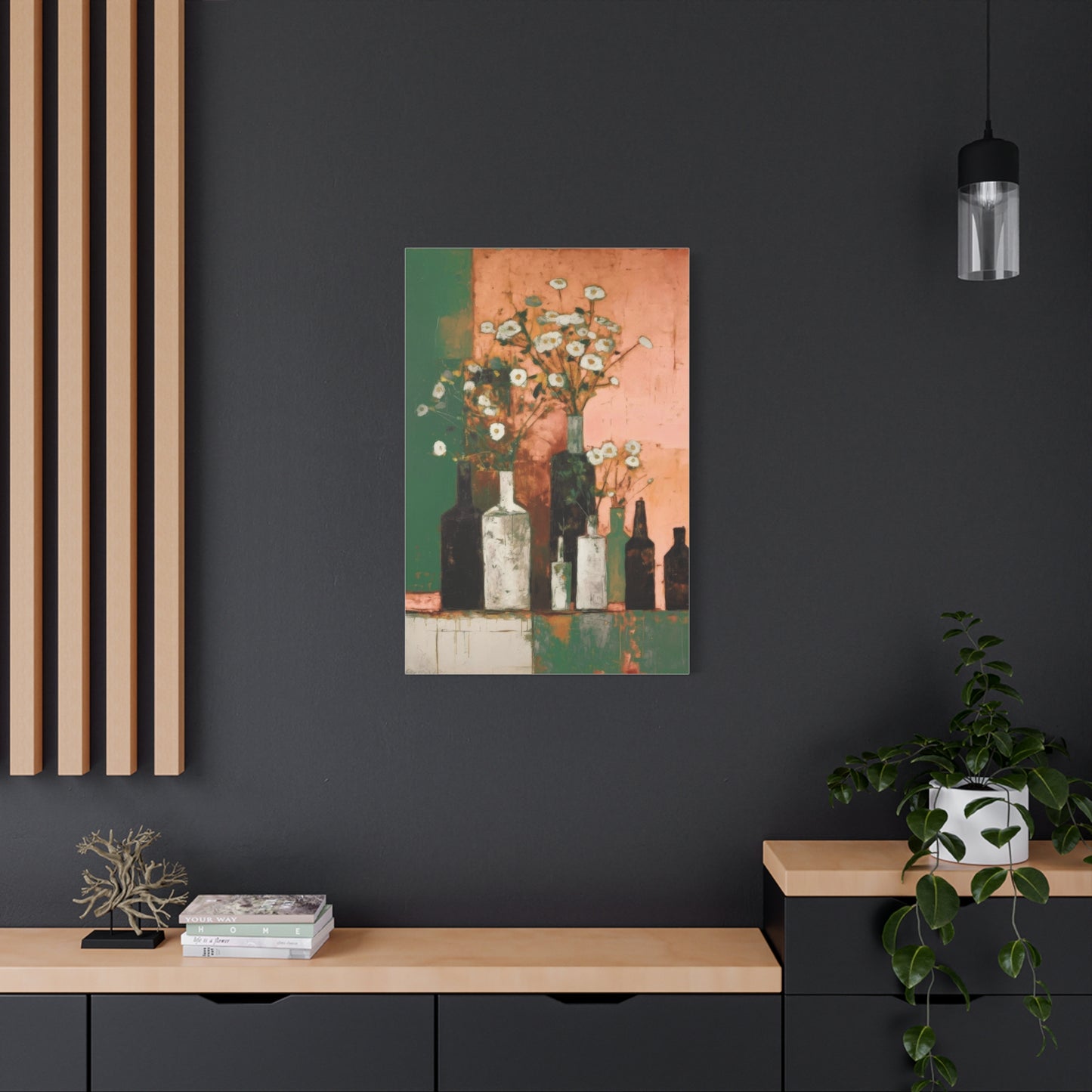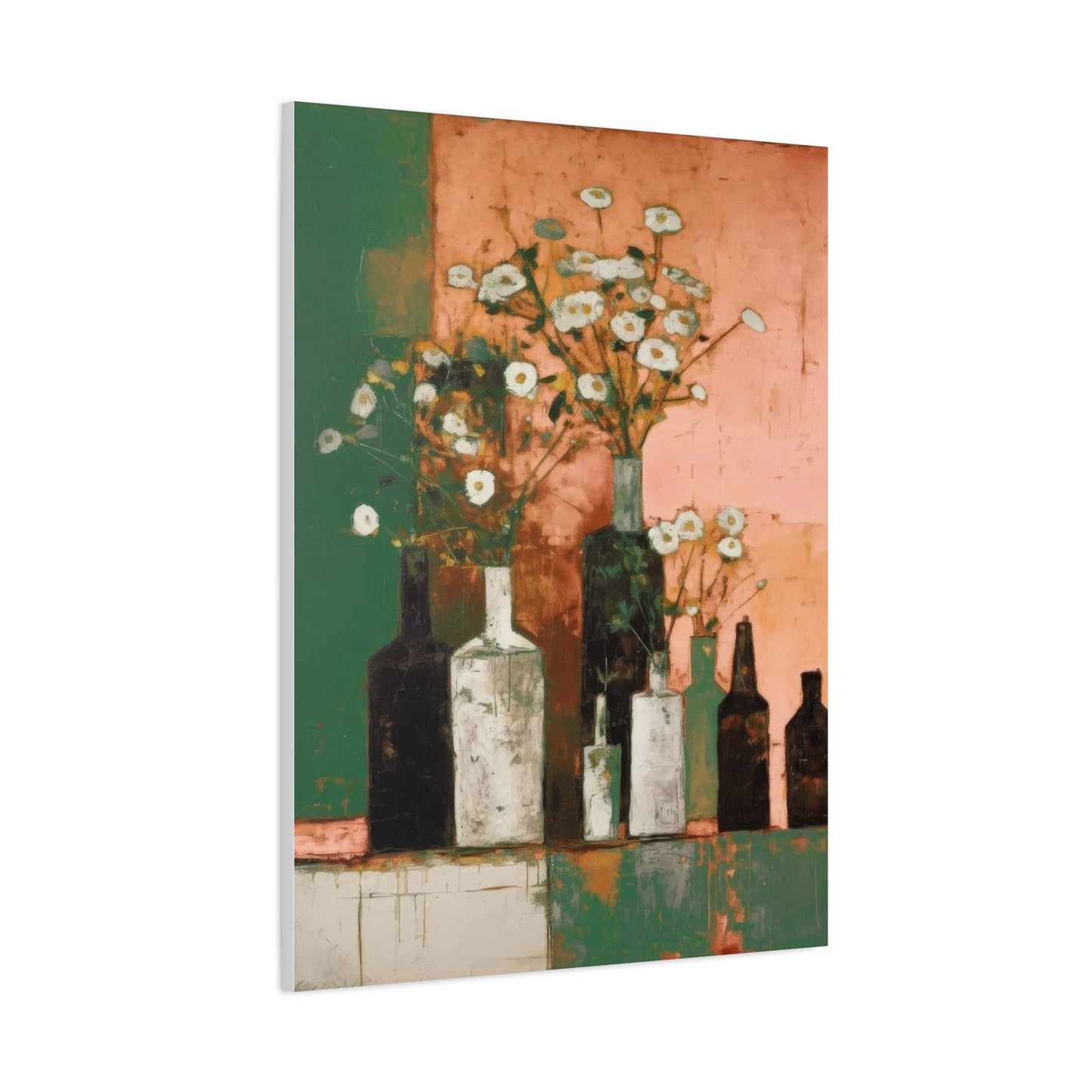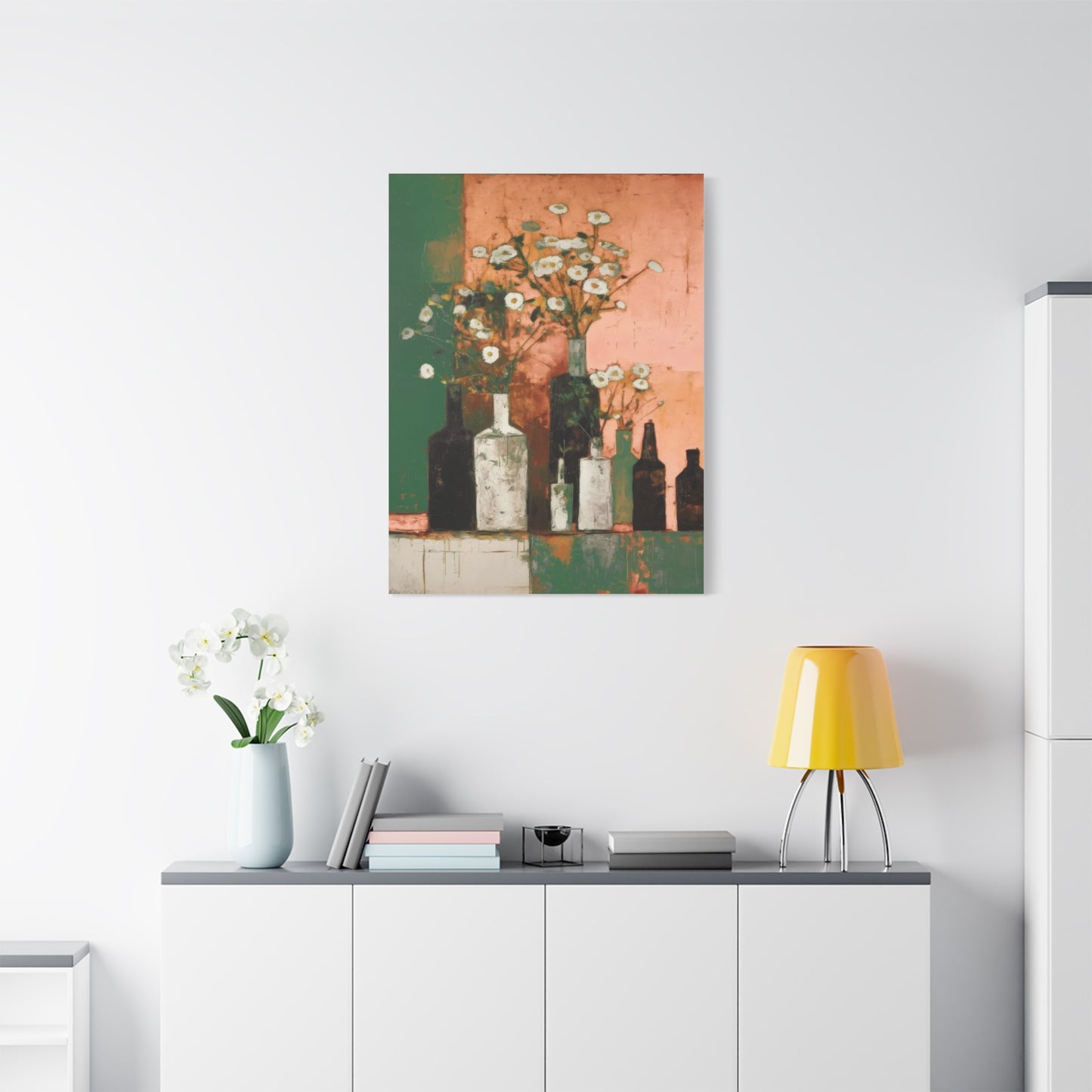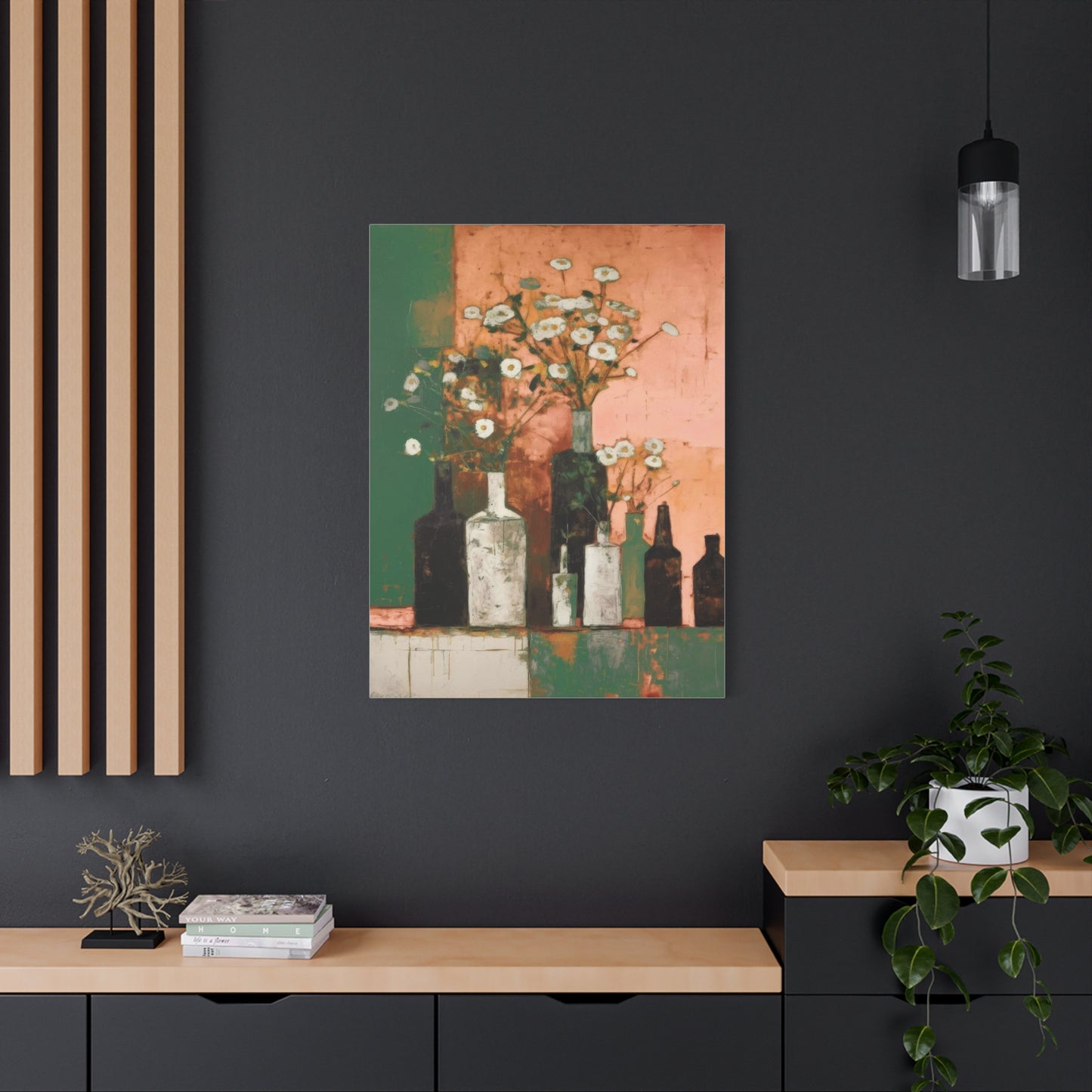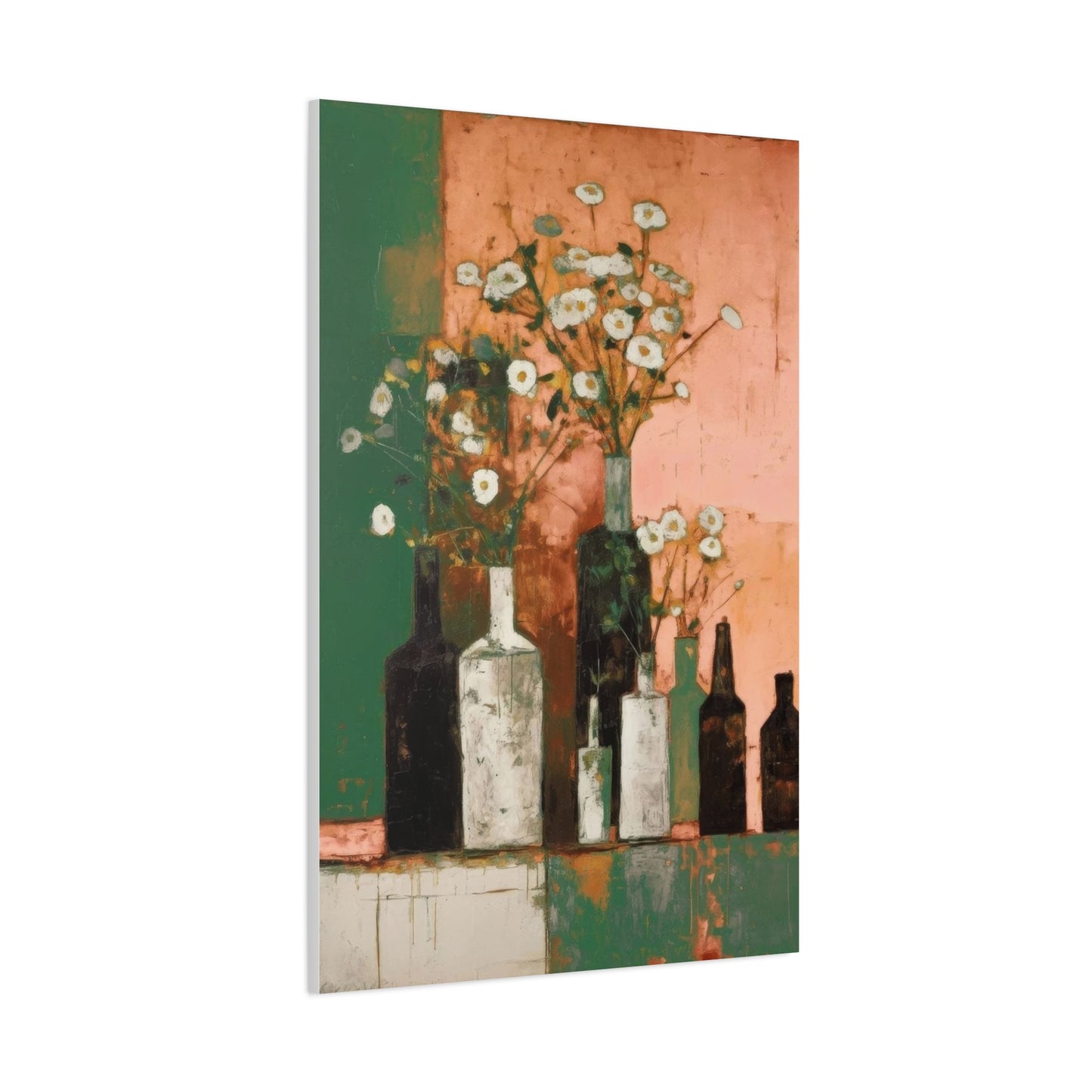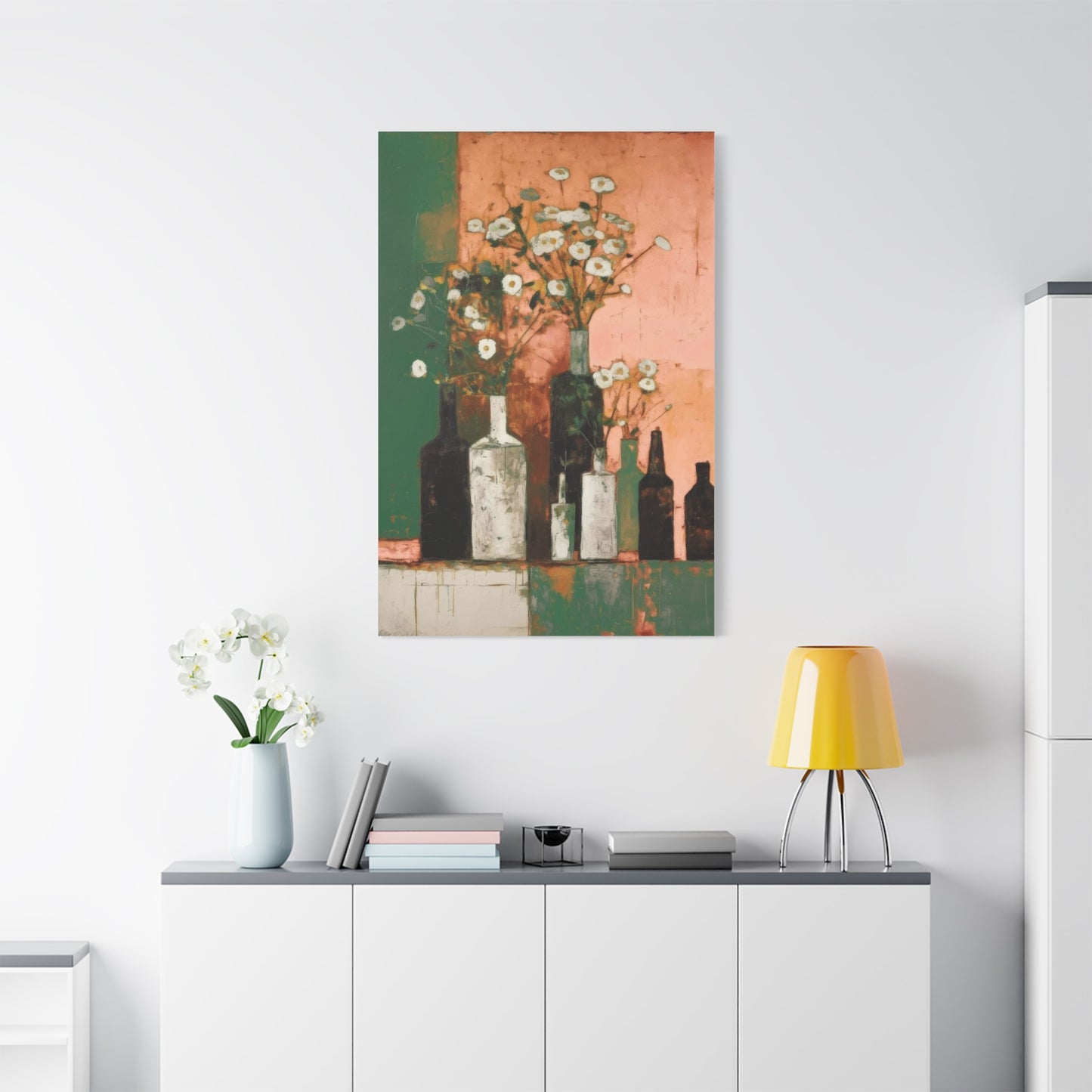Transforming Spaces: How Bottles and Blooms Wall Art Adds Warmth and Personality
Transform your living space into a sanctuary of natural beauty and vintage elegance with the enchanting world of bottles and blooms artwork. This captivating style of home decoration brings together the delicate grace of fresh flowers with the nostalgic charm of vintage glass containers, creating a visual symphony that speaks to both traditional and contemporary sensibilities. When you incorporate this artistic theme into your interior design, you're not simply hanging another piece of wall art; you're inviting a story of timeless beauty, pastoral simplicity, and refined taste into your everyday environment.
The appeal of this decorative approach lies in its remarkable versatility and universal charm. Whether your home embraces minimalist modern aesthetics, celebrates the warmth of farmhouse style, or revels in eclectic bohemian flair, floral artwork featuring vintage containers adapts seamlessly to complement your existing decor. The imagery typically showcases wildflowers, garden blooms, or delicate botanical specimens arranged in weathered glass vessels, creating compositions that feel both curated and naturally spontaneous. This artistic style captures a moment frozen in time, where the transient beauty of nature meets the enduring quality of hand-blown glass, evoking memories of grandmother's garden and simpler times when flowers were gathered from the yard rather than purchased from shops.
What makes this particular aesthetic so compelling is its ability to bridge multiple design eras and cultural influences. The vintage containers reference early twentieth-century domestic life, while the floral arrangements celebrate nature's perpetual renewal. Together, they create artwork that feels simultaneously nostalgic and fresh, making it an ideal choice for homeowners who appreciate traditional elements but want to avoid overly formal or dated appearances. The soft color palettes typically associated with these pieces ranging from muted pastels to rich jewel tones work harmoniously with virtually any wall color and furniture style, providing that perfect finishing touch that makes a house truly feel like home.
In today's fast-paced world, where technology dominates our daily existence and natural connections feel increasingly precious, bringing nature-inspired artwork into our homes serves a deeper purpose than mere decoration. Studies have consistently shown that incorporating botanical elements and natural imagery into interior spaces can reduce stress levels, improve mood, and enhance overall wellbeing. When you select artwork depicting flowers in vintage vessels, you're creating visual rest stops throughout your home where eyes can pause, minds can settle, and spirits can refresh. These artistic focal points remind us of the natural world waiting just beyond our walls, encouraging us to slow down and appreciate the simple beauty that surrounds us.
How Bottles and Blooms Wall Art Adds Whimsy to Any Space
Introducing whimsical elements into home design creates environments that feel lighthearted, creative, and personally meaningful rather than stiff or overly formal. Artwork depicting flowers arranged in vintage glass containers excels at delivering exactly this quality, offering visual interest that delights without overwhelming and charms without becoming childish. The inherent playfulness of this artistic theme stems from its celebration of everyday objects elevated to subjects worthy of artistic attention, reminding us that beauty exists in ordinary moments and common items when we pause to truly see them.
The whimsical nature of these pieces manifests through several key characteristics. First, the combination of delicate florals with weathered, imperfect containers creates delightful visual contrast. The flowers represent nature's ephemeral perfection, while the bottles and jars show the marks of time and use, their surfaces perhaps slightly clouded, their shapes charmingly irregular. This juxtaposition suggests a playful disregard for perfection, celebrating instead the beauty of authenticity and the charm of imperfection. In an age where much of our visual culture has been digitally perfected and filtered, this celebration of real, imperfect beauty feels refreshingly honest and wonderfully whimsical.
Second, the subject matter itself carries inherent whimsy through its suggestion of spontaneous gathering and informal arrangement. These are not formal bouquets from florists, carefully designed and expensively presented. Instead, they appear to be wildflowers gathered during a countryside walk, garden cuttings saved from pruning, or market finds brought home and casually arranged in whatever container was handy. This informality creates a sense of ease and approachability, suggesting homes where creativity matters more than convention and personal expression trumps rigid rules. When guests encounter such artwork in your home, they subconsciously receive the message that your space values authenticity and welcomes relaxation.
The color palettes typically employed in this artistic style further enhance the whimsical quality. Rather than bold, dramatic hues that demand attention, these pieces often feature softer tones, muted pastels, vintage-inspired color combinations, and gentle contrasts. Dusty pinks pair with sage greens, lavender mingles with cream, soft yellows complement weathered blues. These color choices create visual environments that feel dreamy and romantic rather than stark or overly serious. They invite viewers to linger, to look more closely, to discover small details that might be missed during casual glances. This invitation to slow down and truly see represents one of whimsy's greatest gifts in our hurried modern world.
The Timeless Charm of Bottles and Blooms Canvas Prints
Canvas prints offer unique advantages for displaying artwork depicting flowers in vintage containers, combining the visual richness of traditional oil paintings with the accessibility and durability of modern printing technology. The texture of canvas adds depth and dimension that paper prints cannot match, creating surfaces that interact beautifully with light and invite closer examination. When this printing format meets the already charming subject matter of botanical arrangements in weathered glass vessels, the result is artwork that feels both substantial and approachable, suitable for traditional homes yet equally at home in contemporary spaces.
The timeless quality of canvas prints stems partly from their historical associations. For centuries, canvas has been the preferred surface for serious artistic endeavors, from Renaissance masterpieces to modern abstract works. When you choose canvas prints for your home, you're participating in this long artistic tradition, even when the specific images are contemporary creations or photographic reproductions. This connection to art history lends gravitas and cultural significance to what might otherwise be considered simple decoration, elevating the perceived value and importance of your decorating choices. Guests subconsciously register these associations, responding to canvas prints with greater respect and interest than they might show toward paper posters or basic framed prints.
The physical characteristics of canvas contribute significantly to its timeless appeal. Unlike glossy photographic papers that can create glare and reflections, canvas surfaces diffuse light beautifully, remaining visible and appealing from any viewing angle. The subtle texture mimics brushwork, adding visual interest even to digitally created images or photographs. This texture also helps hide minor imperfections and reduces the appearance of visible pixels or printing artifacts that might be more obvious on smooth surfaces. The result is artwork that maintains its beauty over time and continues to please even after years of daily viewing.
Durability represents another crucial advantage of canvas prints. When properly prepared and stretched, canvas prints resist warping, remain taut and smooth, and withstand normal household conditions without special care. They don't require glass, which reduces both weight and cost while eliminating concerns about breakage. This makes canvas prints particularly suitable for high-traffic areas, homes with children or pets, or any situation where fragile materials might be problematic. The long lifespan of quality canvas prints means your investment continues to deliver value for many years, making them economical choices despite sometimes higher initial costs compared to paper alternatives.
The framing options for canvas prints enhance their timeless appeal. Gallery-wrapped canvases, where the image extends around the edges of the stretcher bars, create clean, contemporary presentations that need no additional framing. This approach works beautifully with floral subject matter, allowing the artwork to float on the wall with modern simplicity. Alternatively, framed canvas adds traditional elegance, with wooden frames complementing the vintage aspects of the bottle and bloom imagery. The flexibility to present canvas prints in multiple ways allows homeowners to match artwork to their specific aesthetic preferences while maintaining the inherent quality of the canvas medium.
Add a Touch of Vintage with Bottles and Blooms Art
Vintage aesthetics have experienced remarkable resurgence in recent years, as homeowners increasingly seek to counterbalance modern life's sleek digitality with decorative elements that feel authentic, handcrafted, and connected to earlier eras. Artwork depicting flowers arranged in antique bottles and weathered glass containers serves this desire perfectly, bringing vintage character to contemporary homes without requiring commitment to full period decoration. These pieces function as accessible entry points into vintage styling, allowing even the most modern spaces to incorporate nostalgic touches that add warmth, personality, and historical depth.
The vintage appeal of this artwork style begins with its subject matter. The bottles and jars typically featured in these pieces hail from earlier eras when mass production was less standardized and individual containers showed more variation and character. Milk bottles with embossed lettering, apothecary jars with cork stoppers, preserve jars with wire bails, soda bottles with unique shapes – these vessels tell stories of past commercial practices, domestic routines, and cultural preferences. When featured in artwork, they become visual links to previous generations, creating subtle dialogue between past and present that enriches our understanding of both. Even viewers who don't consciously identify specific bottle types respond to the vintage quality, sensing the historical connections these objects represent.
The flowers themselves contribute to the vintage aesthetic through both variety and presentation style. Rather than showcasing expensive exotic blooms or perfectly groomed florist arrangements, this artwork typically features garden flowers, wildflowers, and modest varieties that our grandparents might have grown and gathered. Daisies, zinnias, cosmos, Queen Anne's lace, black-eyed Susans, and similar accessible blooms predominate, creating arrangements that feel unpretentious and naturally beautiful. The slightly loose, informal arrangement style reinforces period authenticity, as these compositions more closely resemble how people actually arranged flowers in earlier eras before professional floral design became widespread and before social media created pressure for Instagram-perfect presentations.
Color palettes strongly influence how effectively artwork conveys vintage character. Authentic vintage photographs and aged paintings develop particular color characteristics over time, with certain hues fading while others intensify, creating distinctive overall tones. Contemporary artwork seeking to capture vintage aesthetic often mimics these aged color qualities, employing muted rather than brilliant hues, incorporating subtle sepia or gray undertones, and favoring soft pastels over saturated brights. When selecting pieces to add vintage touch to your spaces, pay attention to these color characteristics. Artwork with authentic vintage color sensibilities integrates more successfully with both genuine antiques and modern pieces than artwork with contemporary color palettes, regardless of subject matter.
Bottles and Blooms: A Fresh Take on Classic Floral Wall Art
Floral artwork has adorned human dwellings for millennia, appearing in ancient Egyptian tomb paintings, medieval illuminated manuscripts, Renaissance still lifes, and virtually every artistic movement since. Despite this long history, each generation discovers fresh approaches to representing flowers, ensuring this subject matter never truly becomes dated or exhausted. Contemporary interpretations of botanical subjects in vintage vessels represent exactly this kind of renewal, taking the classic theme of floral decoration and presenting it through perspectives that feel current and relevant to modern sensibilities while honoring the timeless appeal that has made flowers perpetual favorites in decorative arts.
The freshness in this approach emerges from several key elements. First, the combination of flowers with distinctly vintage containers creates fascinating temporal tension. The flowers represent nature's eternal present, blooming now just as their ancestors bloomed centuries ago, while the bottles clearly reference past human eras with their specific shapes, materials, and manufacturing characteristics. This past-meets-present quality gives the artwork conceptual depth beyond simple prettiness, inviting viewers to consider continuity and change, nature and culture, timelessness and specificity. These subtle philosophical dimensions distinguish contemporary floral artwork from purely decorative predecessors that sought only to beautify spaces without engaging minds.
Artistic techniques applied to this subject matter also contribute to the fresh contemporary feel. While some pieces employ traditional watercolor or oil painting approaches, others use photography, digital illustration, mixed media collage, or experimental combinations that would have been impossible in earlier eras. Even when the final image appears traditional, the creation process may have involved thoroughly modern methods. This technical innovation allows artists to achieve effects and qualities that differ from historical floral paintings, ensuring contemporary pieces feel distinct despite thematic similarities to work from previous centuries.
The accessibility of this artwork style creates fresh possibilities for amateur and professional artists alike. Digital tools have democratized art creation, allowing more people to develop and share their visions than ever before. This expanded creative community means greater variety, more diverse perspectives, and fresh interpretations that professional artists bound by market expectations might never explore. When you purchase artwork from independent creators or smaller publishers, you're often acquiring pieces that represent genuinely personal visions rather than market-tested formulas, bringing authentic creative energy into your home.
Color innovation distinguishes contemporary botanical artwork from traditional approaches. While respecting natural flower colors and vintage aesthetic preferences, today's artists also experiment with unexpected palettes, surprising color combinations, and treatments that push beyond strict realism into expressive territory. These chromatic adventures create floral artwork that complements contemporary interiors featuring bold or unusual color schemes, expanding the contexts where botanical subjects work effectively. The fresh approach to color helps floral artwork escape the sometimes too-sweet or overly feminine associations that can limit its appeal, making it suitable for more diverse spaces and audiences.
Why Bottles and Blooms Prints Are Perfect for Cottage-Inspired Homes
Cottage style decoration celebrates simplicity, comfort, natural materials, and unpretentious charm, creating homes that feel welcoming, livable, and connected to pastoral traditions. Artwork depicting flowers in vintage bottles aligns perfectly with cottage aesthetic principles, supporting and enhancing this design approach in multiple ways. Understanding why this synergy works so effectively helps homeowners create cohesive cottage-inspired spaces where every element contributes to the overall vision rather than working at cross purposes.
The fundamental compatibility between cottage style and botanical artwork in vintage vessels stems from shared values. Both celebrate nature, both honor simple pleasures, both find beauty in everyday objects rather than requiring expensive or exotic elements. A cottage garden overflowing with cheerful mixed blooms finds its indoor equivalent in artwork showing abundant flowers casually arranged in repurposed containers. The aesthetic of "making do" with what's at hand, finding beauty in the ordinary, and valuing function alongside form runs through both cottage design philosophy and the specific imagery of flowers in practical vessels. This values alignment creates natural resonance between artwork and overall style.
Color palette compatibility enhances the relationship between cottage style and this artwork category. Cottage interiors typically feature soft, nature-derived colors reminiscent of gardens, seashores, and countryside landscapes. Whites and creams dominate as base colors, accented with gentle pastels, muted brights, and occasional deeper tones that reference vintage textiles or traditional paint colors. Artwork featuring flowers in bottles naturally employs compatible palettes, with botanical subjects providing soft greens, gentle pinks, light blues, warm yellows, and similar hues that harmonize beautifully with cottage color schemes. This color compatibility means you can introduce botanical artwork without worrying about clashing colors or needing to adjust existing palettes to accommodate new pieces.
The romantic quality inherent in cottage style finds perfect expression in floral artwork featuring vintage containers. Romance in design terms doesn't necessarily mean hearts and cherubs but rather a certain softness, nostalgia, and emotional warmth. Cottage style tends toward the romantic rather than the austere, preferring curved lines to hard angles, soft fabrics to slick surfaces, floral patterns to geometric designs. Artwork showing flowers in bottles reinforces these romantic tendencies, adding visual elements that support the emotional tone you're working to create. The slightly dreamlike quality of these images, especially when rendered in soft focus or muted colors, enhances the gentle escapism that makes cottage style so appealing to those seeking refuge from harsh modern realities.
Selecting the Right Bottles and Blooms Wall Art for Your Space
Choosing the perfect bottles and blooms wall art requires careful consideration of several factors that will ensure the piece harmonizes with your existing decor while making the desired visual impact. The first consideration should be the size of the wall space you intend to decorate. Large, empty walls benefit from oversized statement pieces or gallery wall arrangements featuring multiple smaller artworks. Conversely, tight spaces like narrow hallways or the area above a small console table work better with modestly sized pieces that provide visual interest without overwhelming the space.Color palette plays a crucial role in selecting appropriate floral wall art for your home. Examine the dominant and accent colors already present in your room, including wall paint, furniture upholstery, curtains, and decorative accessories. Your bottles and blooms artwork should either complement these existing colors by incorporating similar hues or provide intentional contrast that creates visual excitement. Neutral-toned rooms with beige, gray, or white color schemes can accommodate virtually any floral artwork, while rooms with bold, saturated colors require more careful coordination.
The style and artistic medium of the bottles and blooms wall art should align with your overall interior design approach. Watercolor florals with soft, flowing edges and translucent washes of color work beautifully in romantic, feminine spaces or rooms with a cottage aesthetic. Oil paintings with rich, textured brushstrokes and deep colors suit traditional or classical interiors. Digital prints with clean lines and modern color palettes complement contemporary spaces, while vintage photography or sepia-toned images enhance farmhouse, industrial, or shabby chic designs.Consider the emotional atmosphere you wish to create in the space. Bright, cheerful floral arrangements featuring sunflowers, daisies, or wildflowers in colorful bottles generate uplifting, energetic feelings suitable for kitchens, breakfast nooks, or family rooms. Soft, romantic compositions with roses, peonies, or lavender in delicate glass bottles create peaceful, serene environments ideal for bedrooms, reading nooks, or meditation spaces. Bold, dramatic arrangements with tropical flowers or unusual botanical specimens in interesting containers add excitement and conversation-worthy focal points to dining rooms, entryways, or living rooms.
Different Artistic Styles in Bottles and Blooms Wall Art
The world of bottles and blooms wall art encompasses diverse artistic approaches, each offering unique aesthetic qualities and visual effects. Understanding these different styles helps you make informed decisions when selecting pieces for your home. Watercolor botanical art represents one of the most popular styles, characterized by delicate washes of transparent color that create luminous, ethereal effects. This medium excels at capturing the fragile beauty of flower petals and the reflective qualities of glass bottles, with colors that seem to glow from within the paper.Oil painting techniques bring richness and depth to bottles and blooms compositions through layered brushstrokes and thick applications of pigment that create textural interest. Artists working in oils can achieve dramatic lighting effects, subtle color gradations, and lifelike representations of both flowers and glass containers. The traditional quality of oil paintings makes them particularly suitable for formal spaces or homes decorated in classical, traditional, or transitional styles where timeless elegance takes precedence over trendy contemporary aesthetics.
Acrylic paintings offer versatility that falls between watercolors and oils, capable of producing both transparent glazes and opaque coverage. Artists appreciate acrylics for their quick drying time and ability to create vibrant, saturated colors that maintain their intensity over time. Bottles and blooms artwork created with acrylics often features bold, confident brushwork with strong color contrasts that make powerful visual statements in modern or eclectic interiors.Photography-based bottles and blooms wall art captures real floral arrangements through the lens, offering authentic representations with all the subtle details, textures, and lighting nuances that only reality provides. Some photographers favor crisp, highly detailed images that showcase every petal and dewdrop, while others prefer soft-focus, dreamy interpretations that emphasize mood and atmosphere over precise detail. Black and white photography strips away color to focus on form, contrast, and composition, creating sophisticated, timeless artwork suitable for minimalist or monochromatic design schemes.
Creating a Gallery Wall with Bottles and Blooms Artwork
Gallery walls featuring coordinated collections of bottles and blooms art pieces create impressive visual displays that transform empty walls into curated exhibitions. Planning a successful gallery wall begins with selecting a unified theme that ties the individual pieces together while maintaining enough variety to keep the arrangement visually interesting. You might choose artworks featuring similar color palettes but different floral varieties, or maintain consistent flower types while varying the bottle styles and arrangements.The layout of your gallery wall significantly impacts its overall effect. Symmetrical arrangements with evenly spaced frames in uniform sizes create formal, orderly displays that suit traditional interiors and personalities that appreciate structure and balance. Asymmetrical layouts with varied frame sizes, shapes, and spacing produce dynamic, energetic compositions that feel more casual and contemporary. Grid layouts with identically sized frames in perfect rows and columns offer modern sophistication, while organic, salon-style arrangements with frames of all sizes clustered together create an eclectic, collected-over-time aesthetic.
Before hammering a single nail, arrange your bottles and blooms artwork on the floor in your intended layout pattern. This allows you to experiment with different configurations, swap pieces in and out, and ensure proper spacing between frames. Photograph your favorite arrangements from above so you can reference these images during installation. Many designers recommend maintaining consistent spacing of two to three inches between frames throughout the gallery wall, though this guideline can be adjusted based on your aesthetic preferences and the specific pieces involved.Frame selection plays a crucial role in unifying diverse bottles and blooms artwork into a cohesive gallery wall. Using identical frames in the same color and style creates the strongest sense of unity, even when the artwork within varies considerably. Alternatively, you might select frames in the same color family but with different profiles and details, or maintain one frame style while varying the colors. The matting within frames also contributes to overall cohesion, with consistent mat colors helping disparate images feel more connected.
Incorporating Bottles and Blooms Art in Different Rooms
Each room in your home presents unique opportunities and considerations for displaying bottles and blooms wall art. The living room, being a primary gathering space where you entertain guests and spend considerable leisure time, deserves artwork that makes a strong impression while supporting the room's functional purpose. Large-scale bottles and blooms pieces above the sofa serve as focal points that anchor seating arrangements, while smaller coordinated pieces on adjacent walls provide visual continuity without competing for attention.Bedrooms benefit from bottles and blooms wall art that promotes relaxation and peaceful sleep. Soft, muted color palettes featuring gentle pastels, whites, and subtle earth tones create calming environments conducive to rest. The wall behind the bed offers prime real estate for a substantial piece that serves as a headboard alternative or complement, while artwork on facing walls provides pleasant views upon waking. Avoid overly stimulating colors or busy compositions in sleeping spaces, instead favoring simple, serene arrangements that support the room's primary function.
Kitchen and dining areas welcome cheerful, vibrant bottles and blooms artwork that enhances the convivial atmosphere of shared meals and family gatherings. These spaces can accommodate brighter colors and more playful compositions than bedrooms, including arrangements featuring herbs, vegetables, or fruit-bearing branches mixed with traditional flowers. The informal nature of kitchen decor allows for creative presentation methods like clipboards, chicken wire displays, or shelf-mounted prints that can be easily changed to refresh the space.Bathrooms, often overlooked in decorating plans, become spa-like retreats when adorned with appropriate bottles and blooms wall art. The humid environment requires consideration of materials, with canvas prints, metal prints, or properly sealed and framed pieces being preferable to paper prints that might suffer water damage. Floral arrangements featuring water-loving plants like lotus flowers, water lilies, or tropical blooms feel particularly appropriate in bathroom settings, reinforcing the connection between water, cleansing, and natural beauty.
Seasonal Variations in Bottles and Blooms Decor
Rotating your bottles and blooms wall art seasonally keeps your decor fresh and connected to the natural cycles of the year. Spring artwork featuring cherry blossoms, tulips, daffodils, and fresh green branches celebrates renewal and new beginnings. Light, airy color palettes with soft pastels and crisp whites reflect the season's delicate beauty and awakening energy. Displaying spring-themed bottles and blooms art throughout your home reinforces the sense of possibility and growth that characterizes this time of year.Summer floral wall art bursts with abundant color and lush, fully opened blooms that reflect the season's peak vitality. Sunflowers, dahlias, zinnias, and wildflower meadow arrangements in rustic bottles or mason jars capture summer's casual, carefree spirit. Bolder, more saturated colors including bright yellows, vibrant oranges, and deep purples create energetic displays that complement outdoor-oriented summer lifestyles and increased social entertaining.
Autumn bottles and blooms artwork transitions into warmer, richer color palettes featuring golds, burgundies, burnt oranges, and deep reds. Fall arrangements might include dried flowers, seed pods, autumn foliage, and harvest elements like wheat stalks or decorative gourds alongside traditional blooms. The textures become more varied and substantial, reflecting nature's preparation for winter. These pieces create cozy, welcoming environments perfect for the nesting instinct that emerges as temperatures cool.Winter floral art often features more restrained color palettes with whites, silvers, deep greens, and touches of red that reference holiday traditions. Evergreen branches, holly, winterberries, and elegant white flowers like amaryllis or paperwhites in simple glass bottles create sophisticated seasonal displays. Some homeowners prefer subtle winter artwork that doesn't reference specific holidays, allowing pieces to remain displayed throughout the entire season without feeling dated after celebrations conclude.
DIY Bottles and Blooms Wall Art Projects
Creating your own bottles and blooms wall art allows for complete personalization while offering satisfying creative expression. Photography-based projects provide accessible starting points for beginners. Arrange fresh or dried flowers in interesting bottles, then photograph your compositions using natural window light that creates soft shadows and highlights. Experiment with different angles, backgrounds, and lighting conditions to discover your preferred aesthetic. Print your favorite images through professional photo services, then frame them for display.Pressed flower art offers another approachable DIY option that produces beautiful, delicate results. Collect fresh flowers and foliage, press them between heavy books with absorbent paper, and allow several weeks for complete drying. Once preserved, arrange the pressed botanicals on decorative paper or fabric, securing them with tiny dots of adhesive. Display your compositions in shadow box frames that protect the delicate materials while adding dimensional interest. Vintage bottles can be incorporated by including photographs or illustrations of bottles as background elements.
Watercolor painting provides opportunities for artistic expression even without advanced skills. Simple, loose watercolor washes suggesting flower shapes in bottles create charming, impressionistic artwork that doesn't require precise botanical accuracy. Focus on capturing the essence of floral arrangements through color and form rather than detailed replication. Online tutorials and beginner watercolor classes teach basic techniques for creating beautiful bottles and blooms compositions that reflect your personal style.Mixed media approaches combine various materials and techniques into unique bottles and blooms artwork. Start with a painted or printed background, then add dimensional elements like fabric flowers, paper cutouts, dried botanicals, or small actual bottles attached to the surface. Incorporate text through stamping, handwriting, or transferred prints that add poetic verses, flower meanings, or personal messages. These layered, textural pieces become one-of-a-kind artworks that hold special significance because you created them yourself.
Framing and Presentation Techniques for Floral Art
Proper framing elevates bottles and blooms wall art from simple prints to polished, professional-looking pieces worthy of prominent display. Mat boards create breathing room between artwork and frame edges while adding visual sophistication. White and cream mats offer classic, neutral framing that suits most artwork and decor styles, while colored mats can enhance or complement colors within the artwork itself. Double matting with two layers of different colored mats adds depth and upscale appearance to even modest prints.Frame style selection dramatically impacts how bottles and blooms artwork integrates with surrounding decor. Traditional wooden frames with ornate detailing and rich finishes suit classic, formal interiors and oil or acrylic paintings. Simple, streamlined frames in black, white, or natural wood work well with contemporary spaces and photography or digital prints. Distressed, shabby chic frames complement farmhouse aesthetics and vintage-inspired artwork, while sleek metal frames suit industrial or modern minimalist environments.
Glass versus acrylic glazing represents an important framing decision. Regular glass provides clarity and scratch resistance but adds weight and breakage risk. Non-reflective or museum glass eliminates glare that can obscure artwork in brightly lit spaces but costs considerably more than standard glass. Acrylic glazing weighs less than glass and won't shatter, making it safer for homes with children or in earthquake-prone areas, though it scratches more easily and can develop static that attracts dust.Alternative presentation methods beyond traditional framing offer creative display options for bottles and blooms artwork. Canvas prints stretched over wooden frames require no additional framing, creating modern, gallery-style presentations with artwork extending to the edges. Metal prints infuse images onto specially treated aluminum, producing luminous, contemporary pieces with exceptional durability. Wood prints transfer images onto natural wood surfaces, incorporating the grain and texture into the final effect for rustic, organic presentations.
Lighting Considerations for Floral Wall Art
Proper lighting transforms bottles and blooms wall art from merely visible to truly spectacular, highlighting colors, creating depth, and establishing the right ambiance. Natural daylight provides the most accurate color representation but varies throughout the day and seasons. Position artwork on walls that receive indirect natural light rather than harsh direct sunlight, which can fade colors over time and create glare on glazed frames. North-facing walls in the northern hemisphere receive consistent, cool natural light ideal for artwork display.Picture lights mounted directly above or below bottles and blooms artwork provide focused illumination that draws attention while creating dramatic shadows and highlights. LED picture lights offer energy efficiency, minimal heat production, and long lifespans that protect artwork from heat damage. Adjustable picture lights allow you to direct illumination exactly where needed, emphasizing specific elements within compositions or compensating for awkward architectural features.
Track lighting and directional spotlights offer flexible solutions for illuminating multiple bottles and blooms pieces throughout a room. Position lights at approximately thirty-degree angles to artwork surfaces to minimize glare while providing adequate illumination. Dimmable lighting systems allow you to adjust intensity based on time of day, activity, and desired atmosphere, creating bright, energizing environments during daytime hours and softer, more intimate lighting for evening relaxation.Ambient room lighting impacts how bottles and blooms wall art appears even without direct picture lighting. Warm white bulbs with color temperatures around 2700-3000K create cozy, inviting atmospheres that enhance warm tones like reds, oranges, and yellows in floral artwork while potentially dulling cooler blues and purples. Cool white or daylight bulbs with higher color temperatures provide crisp, clean illumination that accurately represents all colors but may feel less intimate and comfortable in living spaces.
Combining Bottles and Blooms Art with Other Decor Elements
Bottles and blooms wall art achieves maximum impact when thoughtfully coordinated with surrounding decor elements. Furniture placement should complement rather than compete with featured artwork. Position sofas, chairs, or console tables to create viewing areas where the artwork can be appreciated without obstruction. The bottom edge of artwork should typically hang 8-10 inches above furniture backs, creating visual connection while maintaining appropriate spacing.Textile coordination enhances the relationship between bottles and blooms artwork and soft furnishings. Pull accent colors from your artwork into throw pillows, curtains, area rugs, or upholstery fabrics to create intentional color stories throughout the space. The degree of coordination depends on your aesthetic preferences, ranging from exact color matching for harmonious, pulled-together looks to complementary or contrasting colors for more dynamic, energetic interiors.
Decorative accessories placed near bottles and blooms wall art should echo themes, colors, or styles present in the artwork. Actual bottles and vases displayed on nearby shelves or tables reinforce the bottles and blooms theme while adding dimensional interest. Fresh or dried flowers in complementary colors bring living elements that enhance the artwork's botanical themes. Books, candles, or small sculptures in coordinating colors create curated vignettes that feel thoughtfully designed.Architectural elements including molding, wainscoting, or built-in shelving interact with bottles and blooms artwork in ways that either enhance or detract from overall effect. Use architectural features as framing devices, centering artwork within paneled sections or between vertical moldings. Conversely, allow artwork to break free from architectural constraints when appropriate, spanning across multiple panels or extending beyond molding boundaries to create dynamic tension between art and architecture.
The Role of Scale and Proportion in Floral Art Display
Understanding scale and proportion prevents common mistakes that make artwork appear too small, overwhelming, or disconnected from its surroundings. The relationship between wall size and artwork dimensions follows general guidelines that create visually balanced compositions. Artwork should occupy roughly two-thirds to three-quarters of the furniture width beneath it, so a 72-inch sofa pairs well with 48-54 inches of artwork, whether one large piece or a grouping.Ceiling height influences appropriate artwork scale, with taller rooms accommodating and often requiring larger pieces to maintain proper visual weight. Standard 8-foot ceilings suit artwork up to 48 inches tall, while 9-10 foot ceilings can handle pieces up to 60 inches or more. In rooms with very high ceilings, consider large-scale bottles and blooms murals or multiple stacked pieces that create vertical compositions extending upward to fill the available space without appearing lost.
The viewing distance from artwork affects ideal scale, with pieces viewed from greater distances requiring larger sizes to make appropriate impact. Artwork in long hallways seen from far ends needs sufficient scale to remain visible and interesting from a distance. Conversely, intimate spaces where viewers sit close to walls can showcase smaller, more detailed bottles and blooms pieces that reward close examination.Grouping multiple smaller bottles and blooms artworks creates the visual impact of larger pieces while offering compositional flexibility and budget-friendly acquisition. Grid arrangements with four, six, or nine identically sized pieces achieve substantial wall coverage with modest individual artwork dimensions. Asymmetrical groupings can be expanded over time as budget allows, growing organically into substantial displays that feel collected rather than purchased all at once.
Budget-Friendly Options for Bottles and Blooms Decor
Beautiful bottles and blooms wall art doesn't require luxury budgets when you know where to look and how to shop strategically. Digital prints purchased online and printed locally offer substantial savings compared to original artwork or commercially framed pieces. Many independent artists sell high-resolution digital files that you can print at your preferred size through office supply stores or online printing services, then frame yourself using ready-made frames from discount retailers.Thrift stores, estate sales, and antique shops provide treasure hunts for vintage bottles and blooms artwork at fraction of original costs. Look past outdated frames to evaluate artwork quality, as simple reframing transforms dated pieces into fresh decor elements. Vintage botanical prints and flower illustrations, often sold in bulk lots, can be separated and framed individually for personalized gallery walls with authentic aged charm.
Reproductions of public domain artwork offer legitimate access to classical botanical illustrations and vintage floral photography without copyright concerns. Museums and libraries worldwide digitize their collections, making historical images available for personal use. Download high-resolution files of antique bottles and blooms illustrations, print them through quality services, and frame them for sophisticated artwork that appears far more expensive than actual investment.DIY printing and framing projects dramatically reduce costs while allowing complete creative control. Invest in a quality inkjet printer and premium photo paper for producing your own prints at home. Purchase frame supplies including frames, mats, backing, and glazing separately, assembling them yourself for savings of 50-75% compared to custom framing. While initial equipment investments add up, the per-piece cost of subsequent projects drops significantly.
Using Bottles and Blooms Art in Commercial Spaces
Businesses benefit from bottles and blooms wall art that creates inviting atmospheres aligning with brand identities and customer expectations. Restaurants and cafes use floral artwork to establish ambiance appropriate to their cuisine and concept. Farm-to-table establishments favor rustic bottles and blooms pieces featuring wildflowers in mason jars or vintage milk bottles, reinforcing connections to natural, locally sourced ingredients. Upscale restaurants select sophisticated floral arrangements in elegant vessels that communicate refinement and attention to detail.Retail boutiques employ bottles and blooms artwork to enhance shopping experiences and reflect merchandise aesthetics. Clothing stores targeting romantic, feminine demographics display soft, pretty floral artwork that appeals to customer sensibilities while complementing merchandise. Home goods stores create inspiring room vignettes incorporating bottles and blooms art alongside products for sale, demonstrating how customers might use similar pieces in their own homes.
Professional offices including medical practices, dental offices, law firms, and financial institutions use bottles and blooms wall art to soften clinical or intimidating environments. Medical and dental waiting rooms benefit from calming floral artwork that reduces patient anxiety and creates more pleasant experiences during potentially stressful visits. The natural subject matter provides neutral, universally appealing decoration unlikely to offend diverse client populations.Hospitality venues including hotels, bed and breakfasts, and vacation rentals incorporate bottles and blooms artwork to create memorable, Instagram-worthy spaces that guests enjoy and share online. Thoughtfully selected floral art contributes to overall design themes while providing visual interest that elevates spaces above generic corporate hotel decor. Local floral imagery featuring regional wildflowers or native plants adds sense of place that connects visitors to their destination.
Cultural Symbolism in Floral Imagery
Different cultures assign varied meanings to specific flowers, influencing how bottles and blooms wall art resonates with diverse viewers. In Western traditions, roses symbolize love and passion, with red roses specifically representing romantic love, white roses indicating purity or new beginnings, and yellow roses conveying friendship. Bottles and blooms artwork featuring roses carries these associations, making them particularly appropriate for bedrooms, romantic spaces, or as gifts celebrating relationships.Asian cultures hold flowers in high regard with complex symbolic systems. Peonies represent prosperity, honor, and happy marriages in Chinese tradition, making them auspicious choices for homes and wedding gifts. Cherry blossoms symbolize the transient nature of life in Japanese culture, appreciated for their brief but intense beauty. Lotus flowers carry spiritual significance across multiple Asian traditions, representing purity, enlightenment, and rebirth emerging from muddy waters.
Victorian flower language, or floriography, assigned specific meanings to hundreds of flowers, allowing people to send coded messages through bouquet selection. While this detailed language is less widely known today, some associations persist in popular consciousness. Lavender represents devotion and virtue, daisies symbolize innocence and new beginnings, sunflowers convey adoration and loyalty, and lilies can represent purity, rebirth, or sympathy depending on variety and color.Understanding these cultural associations helps you select bottles and blooms wall art aligned with intended messages and appropriate for gift-giving contexts. However, personal response to artwork supersedes historical or cultural symbolism. If particular flowers or compositions resonate aesthetically or emotionally, trust your instincts regardless of traditional meanings. Your home should reflect your individual tastes and values rather than rigid adherence to flower symbolism.
Bottles and Blooms Art in Minimalist Interiors
Minimalist design philosophy emphasizes simplicity, clean lines, and intentional editing, but doesn't require eliminating all decoration. Bottles and blooms wall art can enhance minimalist spaces when selected and displayed with characteristic restraint. Choose pieces with simple compositions featuring single stems or sparse arrangements rather than lush, abundant bouquets. Monochromatic or limited color palettes work better than multicolor explosions in minimalist contexts.Black and white photography of bottles and blooms creates sophisticated, understated artwork perfect for minimalist aesthetics. The absence of color focuses attention on form, line, shadow, and negative space, creating contemplative images that support minimalist principles. Simple botanical line drawings or sketches provide similar effects, offering botanical interest without busy detail or complex color that might overwhelm pared-down interiors.
In minimalist spaces, quality trumps quantity, so invest in fewer, higher-quality bottles and blooms pieces rather than numerous less impressive works. A single stunning photograph or painting commands attention and respect as an intentional design choice, while multiple lesser pieces might appear cluttered or indecisive. Position artwork strategically where it can be appreciated without competition, allowing substantial blank wall space surrounding it that reinforces minimalist aesthetics.Framing for minimalist bottles and blooms artwork should emphasize simplicity and clean lines. Select thin frames in neutral colors including black, white, or natural wood tones without ornate detailing. Consider frameless presentations like canvas stretches or minimally mounted prints that reduce visual noise. The goal is making the artwork itself the focus without decorative frames drawing attention or adding unnecessary complexity.
Maximalist Approaches to Floral Wall Displays
Maximalism celebrates abundance, pattern, color, and layered collections, providing perfect context for exuberant bottles and blooms wall art displays. In maximalist interiors, more truly is more, so embrace salon-style gallery walls covering entire surfaces with floral artwork in various sizes, frames, and styles. Mix vintage and contemporary pieces, different artistic media, and complementary color stories to create rich, visually complex compositions that reward extended viewing.Maximalist bottles and blooms selections favor lush, abundant arrangements bursting with varied flowers, rich colors, and detailed execution. Oil paintings with thick, textural brushwork, watercolors with complex color layering, or highly detailed botanical illustrations suit the maximalist love of visual richness. Don't shy from bold colors, dramatic contrasts, or unusual compositions that make strong statements and contribute to overall sensory abundance.
Layer bottles and blooms wall art with other decorative elements including mirrors, wall sculptures, textile hangings, and collections of three-dimensional objects. In maximalist design, walls become complete environments rather than simple backgrounds, so integrate artwork into larger schemes that include multiple visual layers. Overlap elements slightly or create dense arrangements where negative space becomes the exception rather than the rule.Frame selection in maximalist spaces offers opportunities for decorative excess that would overwhelm minimalist interiors. Ornate gilt frames, heavily carved wooden frames, or decorative painted frames contribute to overall richness and abundance. Mix frame styles within single gallery walls for eclectic energy, or maintain consistent elaborate framing throughout for cohesive maximalist glamour. The key is embracing decorative abundance as intentional design choice rather than visual accident.
Conclusion
Transforming Spaces: How Bottles and Blooms Wall Art Adds Warmth and Personality demonstrates the profound impact that thoughtfully curated, nature-inspired artwork can have on interior spaces. Combining the simple elegance of bottles with the organic beauty of blooms, this style of wall art captures the delicate interplay between human craftsmanship and the natural world. Each piece communicates a sense of serenity, warmth, and charm, transforming walls into focal points that are both visually captivating and emotionally resonant. Bottles and blooms artwork is not merely decorative—it is a medium through which personality, style, and mood converge to elevate the entire ambiance of a room.
At the heart of this artistic trend is its ability to balance simplicity with depth. Bottles, often rendered in glass, ceramic, or metallic finishes, provide structured form and reflective qualities, while blooms—ranging from soft petals to vivid floral arrangements—introduce color, movement, and organic texture. This combination creates a compelling visual rhythm, drawing the eye naturally across the canvas and encouraging contemplation of both form and essence. The result is artwork that feels approachable yet sophisticated, blending timeless design elements with contemporary artistic expression.
From an interior design perspective, bottles and blooms wall art offers remarkable versatility. Its muted, earthy, and pastel tones complement minimalist, Scandinavian, modern rustic, and eclectic décor styles, while its intricate textures and layered compositions add visual interest to more elaborate interiors. Large-scale canvases serve as statement pieces above sofas, dining tables, or beds, anchoring the room’s color palette and setting the tone for complementary décor. Smaller or multi-panel works can be arranged to create galleries, introducing narrative, rhythm, and depth to walls without overwhelming the space. This adaptability ensures that bottles and blooms artwork can enhance both intimate corners and expansive living areas alike.
Lighting plays a crucial role in bringing the nuances of bottles and blooms wall art to life. Natural sunlight accentuates the subtle reflections on bottles, highlights the vibrancy of petals, and reveals delicate textural details. Soft ambient lighting, spotlights, or wall-mounted lamps can emphasize focal areas, create dynamic shadows, and enhance the overall sense of depth and dimensionality. Through careful illumination, the artwork transforms from static décor into an immersive experience, allowing viewers to appreciate both the fine details and the broader compositional harmony.

















